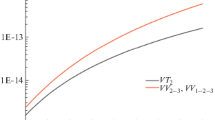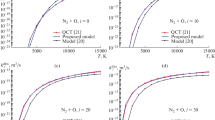Abstract
Numerical modeling of nonequilibrium state-to-state carbon dioxide kinetics is a challenging time-consuming computational task that involves solving a huge system of stiff differential equations and requires optimized methods to solve it. In the present study, we propose and analyse optimizations for the Extended Backward Differential Formula (EBDF) scheme. Using adaptive timesteps instead of fixed ones reduces the number of steps in the algorithm many thousands of times, although with an increase in step complexity. The use of parallel computations to calculate relaxation terms allows one to further reduce the computation time. Numerical experiments on the modeling of spatially homogeneous carbon dioxide vibrational relaxation were performed for optimized computational schemes of different orders. Based on them, the most optimal algorithm of calculations was recommended: a parallel EBDF scheme of fourth-order with an adaptive timestep. This method takes less computational time and memory costs and has the high stability.



Similar content being viewed by others
REFERENCES
C. Park, J. T. Howe, and R. L. Howe, “Review of chemical kinetic problems of future NASA missions, II: Mars entries,” J. Thermophys. Heat Transfer 8, 9–23 (1994). https://doi.org/10.2514/3.496
E. V. Kustova, E. A. Nagnibeda, and I. Armenise, “Vibrational-chemical kinetics in Mars entry problems,” Open Plasma Phys. J. 7, 76–87 (2014). https://doi.org/10.2174/1876534301407010076
T. Silva, M. Grofulovic, B. L. M. Klarenaar, A. S. Morillo-Candas, O. Guaitella, R. Engeln, C. D. Pintassilgo, and V. Guerra, “Kinetic study of low-temperature CO2 plasmas under nonequilibrium conditions. I. Relaxation of vibrational energy,” Plasma Sources Sci. Technol. 27 (2018). https://doi.org/10.1088/1361-6595/aadb60
V. Nevdakh and M. Ganjali, “Vibrational kinetics of the active media of CW CO2 lasers,” J. Appl. Spectrosc. 72, 75–83 (2005). https://doi.org/10.1007/s10812-005-0034-4
E. V. Kustova and E. A. Nagnibeda, “State-to-state theory of vibrational kinetics and dissociation in three-atomic gases,” in Proc. Int. Symp. on Rarefied Gas Dynamics, Sydney, Australia, July 9–14,2000 (American Institute of Physics, Melville, NY, 2001), in Ser.: AIP Conference Proceedings, Vol. 585, pp. 620–627. https://doi.org/10.1063/1.1407618
A. Sahai, B. E. Lopez, C. O. Johnston, and M. Panesi, “Novel approach for CO2 state-to-state modeling and application to multi-dimensional entry flows,” in Proc. AIAA SciTech Forum — 55th AIAA Aerospace Sciences Meeting, Grapevine, TX, Jan. 9–13,2017 (Curran, Red Hook, NY, 2017), paper id. AIAA 2017-0213. https://doi.org/10.2514/6.2017-0213
E. V. Kustova and E. A. Nagnibeda, “On a correct description of a multi-temperature dissociating CO2 flow,” Chem. Phys. 321, 293–310 (2006).
E. V. Kustova and E. A. Nagnibeda, “Kinetic model for multi-temperature flows of reacting carbon dioxide mixture,” Chem. Phys. 398, 111–117 (2012). https://doi.org/10.1016/j.chemphys.2011.05.019
C. W. Gear, Numerical Initial Value Problems in Ordinary Differential Equations (Prentice-Hall, Englewood Cliffs, NJ, 1971).
J. R. Cash, “On the integration of stiff systems of O.D.E.S using extended backward differentiation formulae,” Numer. Math. 34, 235–246 (1980).
E. Alberdi and J. J. Anza, “A predictor modification to the EBDF method for stiff systems,” J. Comput. Math. 29, 199–214 (2011).
L. F. Shampine, “Error estimation and control for ODEs,” J. Sci. Comput. 25, 3–16 (2016). https://doi.org/10.1007/s10915-004-4629-3
V. I. Gorikhovskii and E. A. Nagnibeda, “Energy exchange rate coefficients in modeling carbon dioxide kinetics: calculation optimization,” Vestn. St. Petersburg Univ.: Math. 52, 428–435 (2019). https://doi.org/10.1134/S1063454119040046
M. Lass, S. Mohr, H. Wiebeler, T. D. Kühne, and C. Plessl, “A massively parallel algorithm for the approximate calculation of inverse p-th roots of large sparse matrices,” in Proc. Platform for Advanced Scientific Computing Conf. (PASC’18), Basel, Switzerland, July 2018 (Association for Computing Machinery, New York, 2018), paper No. 7. https://doi.org/10.1145/3218176.3218231
G. Herzberg, Infrared and Raman Spectra of Polyatomic Molecules (D. Van Nostrand, New York, 1951).
I. Armenise and E. V. Kustova, “Mechanisms of coupled vibrational relaxation and dissociation in carbon dioxide,” J. Phys. Chem. 122, 5107–5120 (2018). https://doi.org/10.1021/acs.jpca.8b03266
R. N. Shwartz, Z. I. Slavsky, and K. F. Herzfeld, “Calculation of vibrational relaxation times in gases,” in: Thermodynamic Properties of Individual Substances (Nauka, Moscow, 1962), pp. 399–420 [in Russian].
Funding
The reported study was funded by RFBR, project numbers 19-31-90059 and 18-01-00493). Saint-Petersburg State University, 2020.
Author information
Authors and Affiliations
Corresponding authors
About this article
Cite this article
Gorikhovskii, V.I., Nagnibeda, E.A. Optimization of CO2 Vibrational Kinetics Modeling in the Full State-to-State Approach. Vestnik St.Petersb. Univ.Math. 53, 358–365 (2020). https://doi.org/10.1134/S1063454120030085
Received:
Revised:
Accepted:
Published:
Issue Date:
DOI: https://doi.org/10.1134/S1063454120030085




